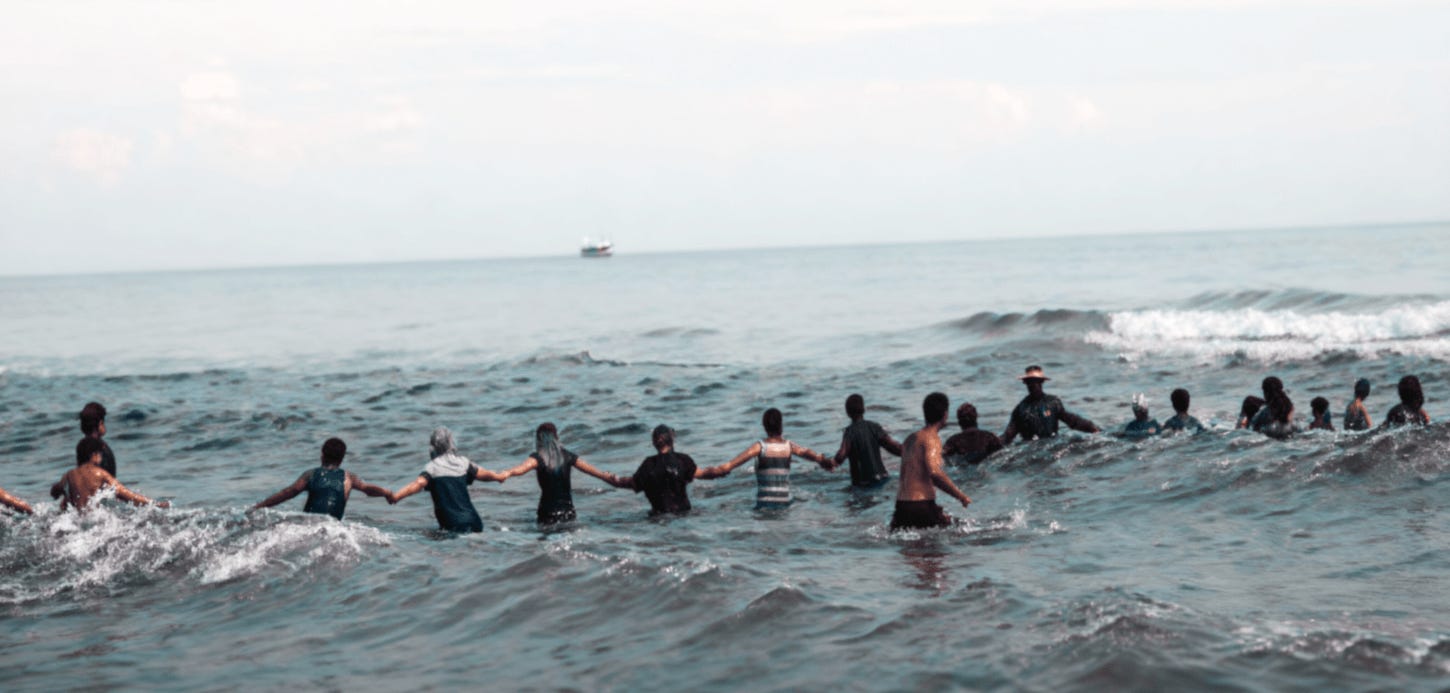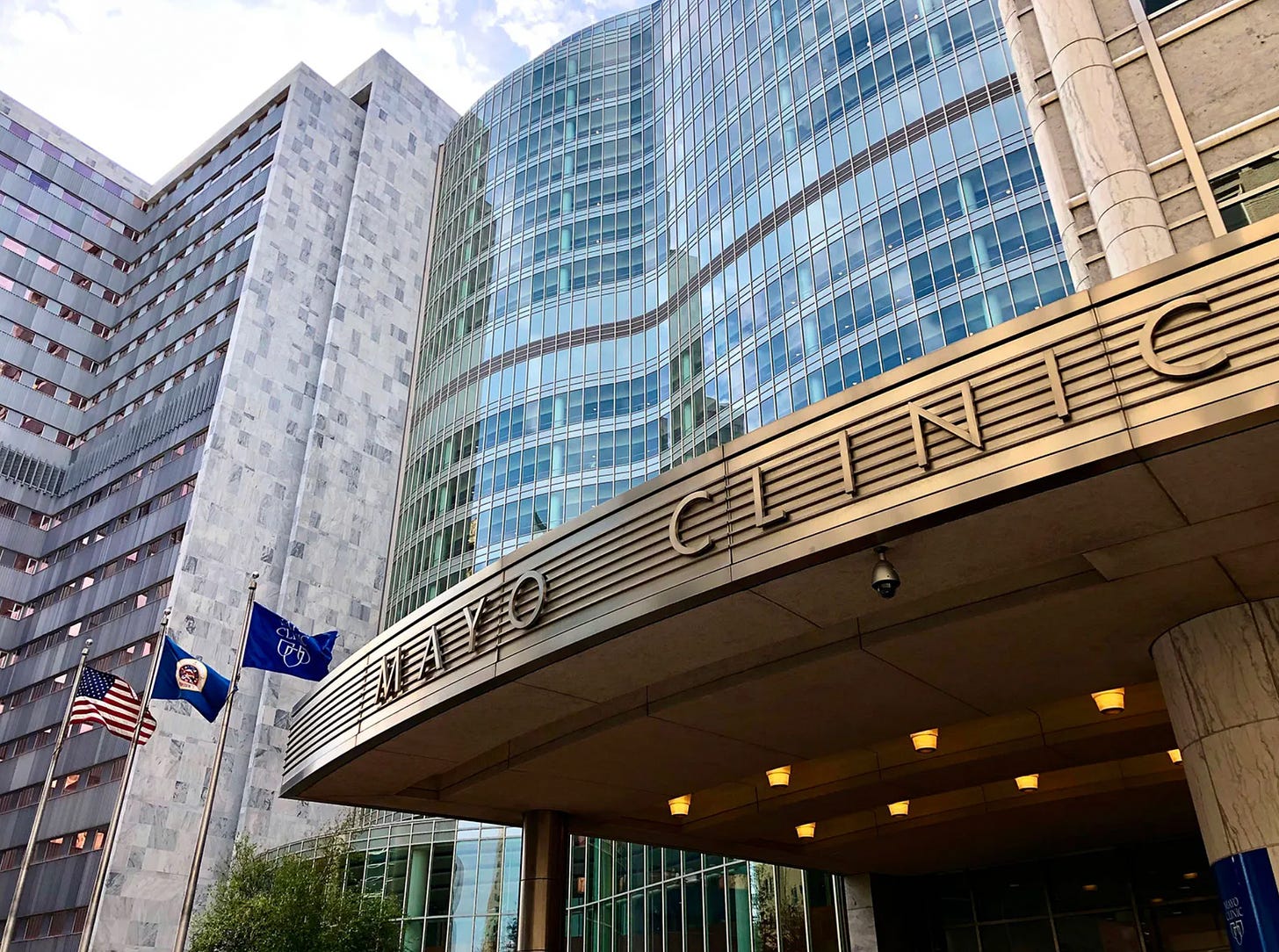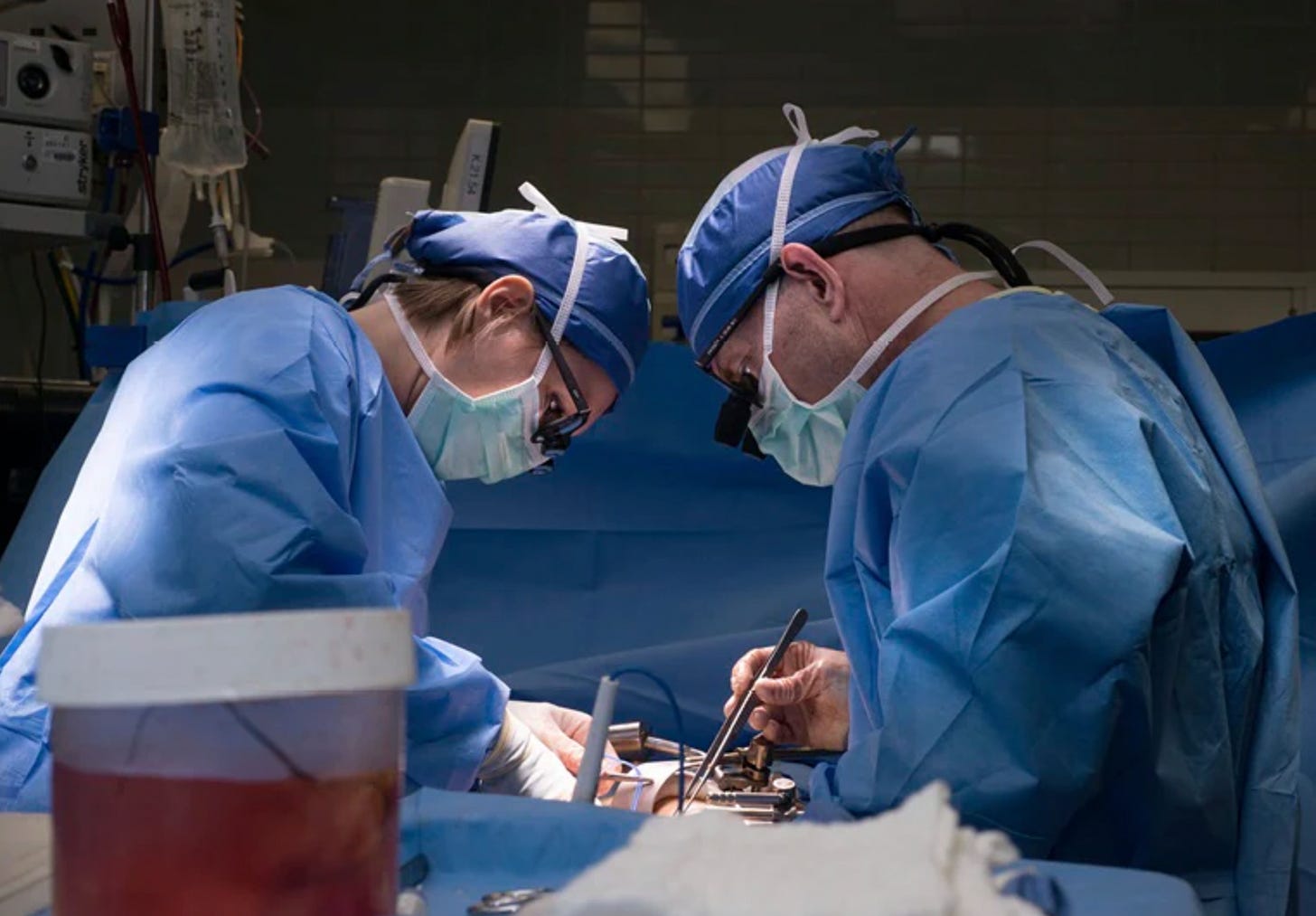Chain of Strangers
My husband was going to die. Until a stranger who heard a podcast saved his life.
For some of us, our lives have a distinct before and after. A singular event so momentous that everything changes –– who we were when the sun crested the horizon is not the same person whose head hits the pillow that night.
In my family, that day was at the end of 2018, when my husband went to a yearly physical and got a panicked phone call a few hours later. Come back immediately, the nurse said. Something is very, very wrong with your blood work.
It appeared, without warning or provocation, that my husband Chris’s kidneys had decided to simply quit working. And most often, when kidneys decide to take themselves offline, they can never be resurrected. Given the right conditions, a liver can regenerate itself. A bone will industriously fill in harmful cracks with new materials.
But once your kidneys have stopped filtering waste, maintaining your body’s fluid levels, monitoring your electrolytes, converting Vitamin D into its active form, telling your bones to make red blood cells, and keeping your blood pressure on the straight and narrow, they will most often never do those jobs again.
There is but one solution: get a new kidney.
It’s simple. But it’s not easy. There are two paths to a kidney transplant. One is that after you’ve been approved to be a kidney recipient, you wait, often many years, for your name to rise high enough on the transplant list to make you eligible for a transplant from a deceased donor.
The other involves finding a living donor who is willing to give up one of their healthy kidneys so you can get one in return. Sometimes this is done via direct donation: Sally donates directly to Bob. Other times –– and many organ transplant centers will tell you this is their preferred method –– a donor chain is initiated. Sally donates to Lisa, and in return, Lisa’s son George donates to Bob. Donor chains allow multiple people to receive transplants on one day.
Some donor chains have more than a dozen people involved in a complicated web of human interconnectedness that would boggle the minds of the people who came before us. Imagine telling John and Abigail Adams when they became the first occupants of the White House in 1800 that, 225 years in the future, men and women with precision instruments would remove fully functioning organs from healthy people, put them in a cooler, and load them into a hollow metal tube that flies through the air at hundreds of miles per hour, and then, at their destination, more physicians would sew the organs into the bodies of the sick. At the end of the day, everyone –– astonishingly –– would live. For comparison, the Adamses’ daughter underwent a mastectomy at their home in Massachusetts without anesthesia.
Shortly after Chris’s Stage V kidney failure diagnosis, we sought treatment at the Mayo Clinic in Minnesota –– among the best transplant centers in the world. Chris is perhaps one of the most selfless people you’ll ever meet –– much of his enjoyment in life comes from helping others. He has spent countless hours volunteering for any number of untold things.
The number of nonprofit boards Chris has served on is more than a dozen. The number of times a worker at a homeless shelter, food pantry, preschool that serves low income families, or domestic violence organization has called Chris, looking for a miracle and finding one on the other end of the phone, would fill an encyclopedic volume. “A pipe just burst,” they might say. He would find a plumber to come fix it, often at no cost to the beleaguered organization.
Another caller said, “We didn’t get a milk delivery this week because of the bad weather.” Chris didn’t hesitate to brave the conditions in his pickup and drop off whatever was needed to bridge the gap. He has personally raised more than $25 million for nonprofits –– a feat I have yet to match. (But I do hope the combined $38+ million in funds raised between us is something the McMahon Clan will be remembered for.)
Side note: After I finished writing this, I went to vote on November 4. The election worker took my name and then asked, “Are you married to Chris?” I told her I was. “What a wonderful guy,” she said. “We worked together on the United Way food drive.” The timing of having just completed this piece and having someone I didn’t know immediately remark on Chris’s community service seemed too apropos to leave out.
Suffice it to say: Chris would never ask anyone for a kidney. The social worker in the transplant program cautioned us about jumping headlong into a scenario in which I would donate one of my kidneys directly to Chris, despite the fact that we share a blood type, one of the most crucial factors in determining what makes someone a match for organ transplantation. (Oh, have I mentioned that Chris also has the kind of special blood that they can give to the most vulnerable patients, like NICU babies, and that he has donated 20 gallons of his own blood over the years?)
The social worker told us that recovery from an organ transplant is long and difficult –– it requires near daily hospital visits for many weeks, even after being discharged from an in-patient stay. Recovery for donors is much simpler than it is for recipients: they will allow you to be a donor only if you are exceptionally healthy to begin with, so you are not recovering from both surgery and an illness.
And removing a kidney is much more simple than adding a foreign one to the body of a sick patient while managing the dizzying cocktail of drugs that keeps the recipient alive. The medication management is so significant that it requires specialty transplant-only pharmacists to provide appropriate care.
Because both the donor and the recipient need care after the surgery and we have four children who need parents, both of us having surgery on the same day was less than ideal. If another option existed, they told us, we should pursue that instead.
We left the multi-day visit saying we would consider the options. Over the next year, Chris became sicker and weaker. He could never get warm –– a side effect of the toxin buildup in your bloodstream. In the winter, he would stand inches from our wood burning stove, willing the heat to warm his bones. He couldn’t keep food down. By 6:00 p.m., he was asleep for the night.
Other people in my family –– distressed at the thought of losing a beloved family member or the idea that our children would lose their father –– went through the initial screening process to see if they could qualify as a match. Some were initially disqualified for a history of high blood pressure or kidney stones, for too many years as a smoker, or other lifestyle issues that made them less than an ideal candidate. Others, like my own mother, didn’t share a blood type with Chris and couldn’t give him one of their kidneys even if they wanted to.
By early March 2020, I had made up my mind: we would figure out the logistical issues of caring for the children if need be, and I would go through the highly involved process of being screened to be a direct donor. It involves a battery of extensive testing to satisfy the transplant board that your lifespan and quality of life are unlikely to be impacted by donation.
Dozens of tubes of blood were siphoned from my arm. I underwent lengthy kidney function tests, and a CT scan with contrast to get a good look at my anatomy. I had multiple cancer screenings, like a mammogram, and wore a blood pressure monitor overnight.
At the end of three days of testing, I met with the nephrologist. “You are extremely healthy,” he told me. “You are an ideal donor, except for one problem.” He pulled up my CT scan, revealing a two millimeter kidney stone. It looked like a grain of salt. “Have you ever had symptomatic kidney stones?” he asked. I had not.
He told me that many people have kidney stones, but they never become dislodged and try to make a painful exit from the premises. They can live there forever, or they can be absorbed by your body. But that grain of salt was disqualifying –– at least for now. One thing I learned about organ donation is that you cannot simply say, “Well, I understand the risks and wish to proceed anyway.” If, for any reason, the transplant center determines that you fall outside of their guidelines, they will simply not do the surgery. The stringent rules are there to protect donors and recipients, but they probably screen out people like me who have never had an issue with symptomatic kidney stones and would likely be just fine.
I was sent home to be on an anti-kidney-stone diet, to see if it would dissolve. Turns out: many of the things I ate and drank regularly –– leafy greens, dark chocolate, almonds, black tea –– can contribute to the formation of stones. Cut them out for three months, they told me, and come back for a recheck.
By now you’ve already heard the rumble of the train barreling toward us: March 11, 2020, when Covid was officially declared a pandemic, and when elective surgeries like transplants were shut down.
Before any vaccines or treatments for Covid existed, as many as one-third of patients with advanced kidney failure died if they caught the virus. Another large percentage lost their transplanted organs. Our instructions were to do absolutely everything we could not to catch it while waiting for what was next. That meant even our healthy children, who would likely recover fully if they were infected, still had to go out of their way not to be an asymptomatic carrier and pass it on to their dad, who was growing more ill by the day. We spent months watching Netflix and getting groceries delivered. Our oldest son, who had a job, moved in with a friend so that he could continue working.
In July 2020, we got a phone call from the transplant center. A match had been found as part of a donor chain. If my mom would be willing to donate one of her kidneys to a stranger in Wisconsin, then Chris could get one from a stranger in Texas.
My mom, as it turned out, had better kidneys than a woman half her age. And the donor Chris would be receiving from was about as ideal a match as one could get. Chris is 6’5”, and one factor transplant programs consider is whether an organ is reasonably sized for a recipient. While the kidney of a 4’11” woman might not be automatically excluded, they would prefer to transplant kidneys that are about the size your body needs.
My mother insisted that she very much wanted to donate her kidney, despite my protestations that she did not need to do this. “What greater gift can I give my grandchildren than prolonging the life of their father?” she asked.
The wheels moved quickly from there: the date was set for three weeks later, and on the morning of the donor chain surgery, the kidney of a 26-year-old electrician was put on a Southwest Airlines flight bound for Minnesota, and the kidney of a nearly 63-year-old woman, my mother, was sent to someone in Wisconsin whose identity we have yet to learn.
Magnus, the nickname Chris gave his donor kidney, began working as soon as the transplant surgeon hooked up the blood supply. Chris just had his five year post-transplant visit, and his doctors say it’s not possible for him to have had a better outcome. His single functioning kidney, given to him altruistically by a man who heard a podcast about organ donation, now performs as well as the two kidneys of his same-age peers.
My mother’s remaining kidney has grown in capacity, admirably picking up the slack for her former partner. Despite the fact that she has only one left, her kidney function runs laps around that of some of her friends who still have both of theirs.
Yes, we are constantly surrounded by bad news on the healthcare front: insurance costs are through the roof, and Americans still have unequal access to quality care. Wait times for doctors are long, and federal health research has been mortally wounded.
But every day, men and women piloting hollow metal tubes at 32,000 feet above a rock orbiting a star are carrying something truly extraordinary: a kidney, skillfully removed by the hands of a surgeon, hurtling towards a new destiny inside the body of someone whose life it will save.






Even though I've read and heard your retelling of this story, I learn something new each time. I am awed that such a transaction can happen in our world today. God bless your mother, Chris, his donor and Magnus!
My 37 year old daughter donated her kidney almost 1 year ago to save her best friends life. Her friend was on dialysis for almost 3 years and in extremely poor health. They didn’t match so my daughter entered the Kidney donor program. Surgery was a success! My daughters kidney was jetted away to someone in need and we heard the patient received it well🙏 In the mean time It moved her friend up on the list. It took another 8 months for her friend to finally receive a donor kidney🙏 She is thriving!!!! Healthy and back to living life. Such a wonderful outcome for all.
One of the thank you gifts my daughter received from hospital is a water jug that says “I’m a Living Kidney Donor, what’s your super power” 🙏❤️
So glad Chris, your mom and the recipient had such an amazing outcome❤️